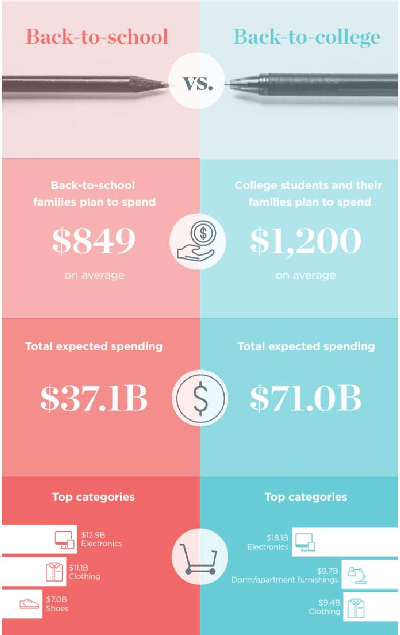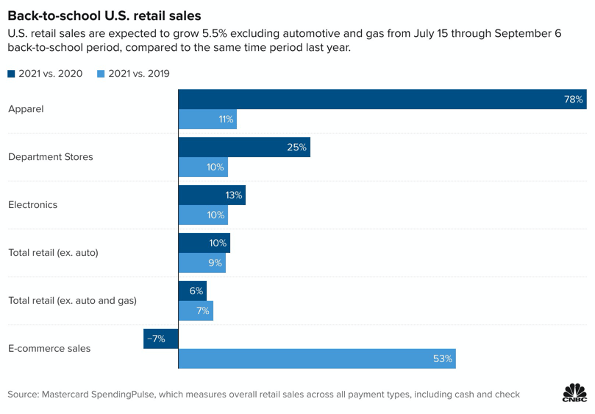
Under Pressure
Shortages and the changing “Back-to-School” landscape
Come August, most parents are ready for their kids to get back into the classroom. But with the COVID-19 pandemic affecting the usual Back-to-School season in 2020, parents are especially eager for the return to the classroom this year. Last year, with COVID-19 still an imminent threat and no vaccine in sight, “Back-to-School” looked very different. Parents invested in technology to help their kids navigate remote learning, pushing tech to the forefront of Back-to-School spending. On top of the boost in tech sales from families, the transition to at-home work also put pressure on tech supply chains. “Now, the impact of the supply crunch is spreading to consumer tech. Apple CEO Tim Cook warned last week that a limited supply of semiconductors would hurt sales of iPhones. Microsoft is struggling to make enough Xbox consoles and Surface laptops” (Vox, 2021).
According to an article in CNNBusiness, “that demand is also coming face-to-face with tight inventory levels and delayed shipments which will impact retailers’ ability to replenish products on shelves later in the season”. The COVID-19 shortages and shipping delays have affected pretty much everyone in the last year. With the return to the classroom, the “categories in most danger of shortages include backpacks, stationery, sports equipment, laptops and tablets.” (CNN, 2021).

These stresses on already-strapped supply chains are worrying consumers, with “fifty percent of shoppers are concerned about stockouts, especially for tech items,” according to Rod Sides, vice chairman and US retail lead with Deloitte. One such area people might not think about as Back-to-School items are home goods for college dorm rooms, such as futons, chairs, etc. With furniture shipping delays sometimes being months-long, and in-store stock selling out repeatedly, this could also be a pain point for shoppers.

Aside from more recent boosts in tech sales, apparel and shoes are always a hot commodity during this season. According to the graph above, apparel sales are expected to grow by 78% over last year. Unfortunately, the combination of goods shortages and increased demands makes consumers who are desperate for certain products especially vulnerable to counterfeits. Sneakers are one of the top-selling items for children during this season, and are just one opportunity counterfeiters across the board are sure to capitalize on. It’s up to companies to educate their consumers on the dangers of counterfeiting, and introduce clear ways for shoppers to ensure they’re getting reliable goods this Back-to-School season.

Falling for Fakes
The importance of consumer counterfeit education
With counterfeits, consumer education is extremely important and can be very impactful for your business. According to a 2018 survey by Red Points, ”initially, parents’ opinion was split when asked if they were concerned about the problem of fake back-to-school items online, with half of the respondents saying they were concerned and the other half expressing little interest in the issue. However, when told about the dangers associated with fakes, the majority of respondents (44.7 percent) said this would drastically change their buying habits.”
Last month, CNN reported how “with items like sneakers, backpacks and gadgets expected to be in tight supply earlier than normal, parents are bracing for shortages…That desperation is triggering the BBB [Better Business Bureau] to issue a warning about online shopping scams. It is urging consumers to verify third-party vendors found through ads on social media” (CNN, July 2021). Making education a part of your marketing strategy will not only position you as an expert on the matter, but will also help you build trust with your customers. Most consumers don’t want to buy fake products—they’re often duped by third-party sellers because they haven’t been equipped with the tools necessary to vet their options.
“U.S. Customs and Border Patrol (CBP) data reveals that while counterfeit apparel and accessories are currently the top seized counterfeit products, counterfeit apparel and accessories only represent 20% of all seizures. Consumer electronics, like cell phone chargers and headphones, account for 16% of seizures. Medicines and personal care products, including vitamins, supplements, and cosmetics, follow close behind in the ranks. The newest scare: counterfeit backpacks containing excessive amounts of lead.”

The combination of a rise in demand for a product, with a low supply, and an increase in counterfeit availability, creates a very dangerous situation. Take the backpack example. In the same Red Points survey referenced above, “of those buying knock-off school supplies, half of the respondents said they bought the fake items by mistake,” and “the majority of respondents listed backpacks (27.4 percent) as the most common fake back-to-school item they bought online”.
The only way you can combat counterfeits is through accurate data and transparency to your consumers. Having systems in place that quickly identify counterfeit products allows you to promptly remove them from your supply chain. Along with stopping counterfeits, supply chain visibility allows you to have better tabs on your inventory, which makes you more prepared for busy seasons. The supply chain shortages and counterfeit sales are issues that dovetail into one another. Finding the right solution to tackle both can feel daunting, but luckily, we’re here to help.

Stop, Look, and Respond
How transparent supply chains will make you stand out
The best way to plan is to know what you’re preparing for. The best way to forecast trends? Looking at historical data and applying it to real-time situations. Having intelligent insights into your inventory across your supply chain will allow you to better forecast surges in consumer activity, because it will allow you to pinpoint when these surges have happened in the past. Transparency throughout your supply chain will also allow you to better set expectations for your consumers. After all, you can’t accurately report shipping times if you’re unsure when your next batch of products is leaving your factories.
“We’re also experiencing the fallout of the so-called just-in-time-based inventory models that have become increasingly popular in recent decades” (The Strategist, 2021). It’s understandable that companies don’t want to hold onto unnecessary inventory—but relying on in-the-moment production also puts businesses at risk during times of disruption. Having clear insights into your inventory will allow you to assess your own vulnerabilities, and be more prepared for the things you can prepare for—like Back-to-School shopping surges.
Having reliable data is the foundation for any solution around supply chain, and counterfeit, issues. Additionally, sharing that relevant data with your consumers is one of the most powerful marketing tools companies can employ. Consumers want transparency, and are much more likely to support companies who set clear expectations around shipping and inventory, and educate them on their products. The companies who are able to do this amidst changing landscapes are the ones who will succeed, even in the most trying of times.